Love blossoms
Besotted with Western Australia’s wildflowers.
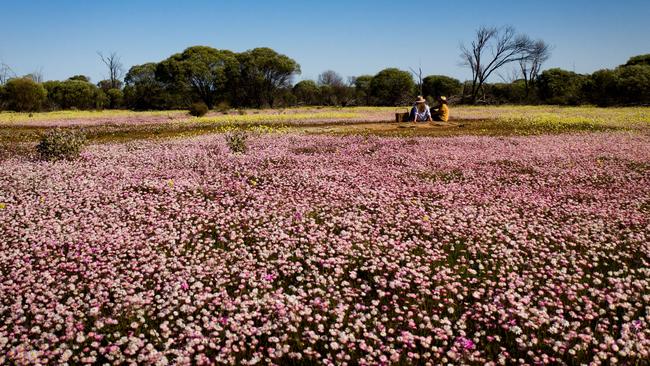
The blades on the windmill are turning, producing nothing but an eerie squeak. The creek bed is dry and tumbles through the harsh, red landscape. Desert finches dart between hardy bushes, flashes of movement in an otherwise still landscape. Bursting from this dusty, rusty scene are exquisite flowers; tiny pompom everlastings in their tens of thousands, yellow and white, each one with delicate petals and fragile stems. They colour the unforgiving land for kilometres.
I’m at Koolanooka Springs, 370km northeast of Perth, on a self-guided road trip through wildflower country. Together with my travel buddy, I’m visiting sleepy rural towns, traversing mulga bushland and skirting paddocks of green spring crops and impossibly golden canola. Climbing back into the car, I’m grinning from ear to ear and feeling euphoric. I think I’m in love. With wildflowers.
It’s not as crazy as it sounds. Scientists say flowers can trigger similar “happy” hormones to those produced in the throes of a love affair. For millennia, flowers have signalled to human brains the arrival of spring, and abundant food. The giving of blooms has long been associated with appreciation. Floral colours elicit a response, too, with red and yellow providing an energetic uplift and blue and white eliciting calm. These factors could all be triggering a hit of oxytocin, serotonin and dopamine.

The first stop of our adventure was the Wongan Hills Visitor Centre, 190km from Perth. Here, friendly volunteers in the information centre ply us with maps and updated wildflower locations. On the way to Mount O’Brien lookout, we drive through head-high “pink pokers”, outrageous yellow wattles and waist-high shrubs of an unfathomable purple.
The town of Dalwallinu is the official start of the Wildflower Way, a driving route through WA’s wheatbelt, stretching north to Geraldton. Interpretative signage along the way includes beautiful steel sculptures celebrating indigenous and early European heritage.
We drop in at Dalwallinu’s old well, finding flowers right by the carpark. A purple fringe lily, petals lined with mini-tassels, climbs through flowering bushes like Christmas tinsel. Next, we spot the orange immortelle with its sunset colours, native fuchsia with bell-shaped pink droplets, and little paper daisies in pink, white and yellow.
Top of the wishlist for many wildflower-spotters is the elusive wreath flower. Growing outwards in a flat circle, yellow and pink blossoms decorate their outer rim. Wreaths love disturbed sandy soil, making roadside verges a favourite. Locals kindly mark the locations for tourists, and we’re told to look out for various pointers, such as a pile of rocks or a dishcloth tied on a reflector post. Near the town of Wubin we find our first wreaths, and they’re unlike anything we’ve seen. Together with a couple of caravaners, we swoon over the cluster of five circular marvels.
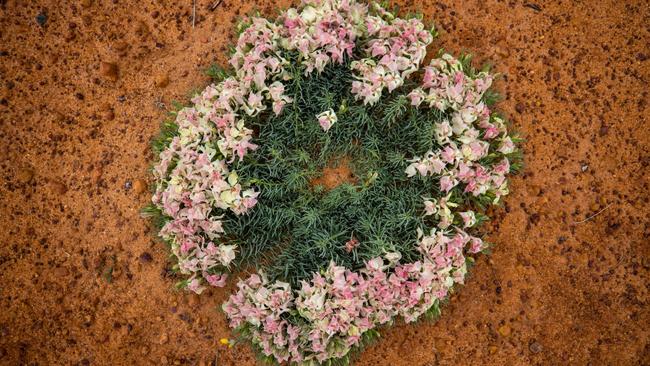
Along unsealed backroads there are unexpected treasures, such as historic Cailbro School, a mud brick structure that has been restored by former students. In the old play area, swathes of white everlastings dust the ground like snow.
Nature impresses in other ways, too. A flock of about 30 parrots blaze turquoise through the trees and we frequently slow down to avoid chunky bobtail lizards. We stop to admire seven emus, Dad leading his six adolescents through wheat stubble. Spotting me, they stretch up to their full height before turning to flounce off.
Back on the trail, we discover finding orchids takes some effort, but we’re thrilled with the rewards. Buntine Rock is a large arc of granite erupting from the landscape. Around the base we discover delicate donkey orchids, the floral equine face with comical ears in brilliant yellow and orange. The climb to the top yields sweeping views of the district.
After checking into a tidy cabin at the Perenjori Caravan Park, dinner beckons. The classic Perenjori Hotel is buzzing on a Monday night with a mix of customers as eclectic as its decorations. Flannelette-shirted farmers enjoy a well-earned ale while grey nomads compare wildflower photos over generous steaks. On the bar’s television, the Freo Dockers are winning the footy, and the one-eyed crowd couldn’t be happier.
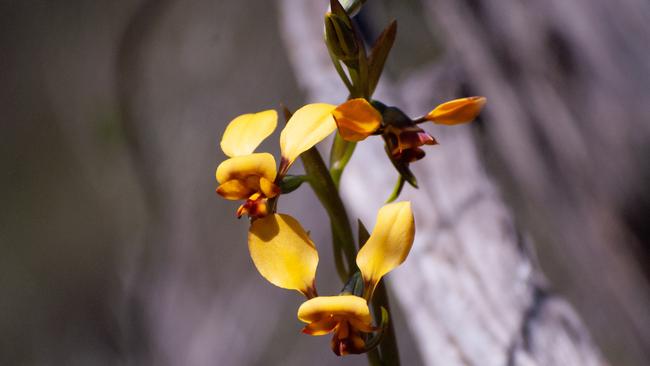
Back on the hunt early, we come to the big-hearted hamlet of Canna. The sight of a general store fills us with hope of coffee, until we read the sign saying it closed in 2003. To console us, residents have kindly provided some updated wildflower maps, and armed with our own Thermos of coffee, we find bright yellow cowslip orchids, and a dainty blue fairy orchid.
Next stop is Coalseam Conservation Park. It was briefly mined for coal from 1917, but the real pay dirt here is the flowers. Beside a lookout above the Irwin River, we picnic among bountiful everlastings, waitzias and flowering shrubs, deliriously happy.
Approaching our overnight accommodation, the desert glows in the afternoon light and a red kangaroo soars effortlessly over a fence. Underlining the point, we pass a sign that declares “The Outback Starts Here”. Several wreath flowers line the roadside and we stop to admire them as galahs squabble in the treetops.
At Mellenbye Station Stay we’re greeted at the homestead by manager Shelley Bogdan. A working cattle property, Mellenbye offers accommodation in the restored homestead, along with camping. Our pad for the night is a brand-new cottage, with oodles of outdoor space and its own romantic firepit.
Shelley tells me why visitors are drawn here. “People want the experience of being out in ‘big sky country’ and seeing something that’s different, and even being a little out of their comfort zone,” she says.
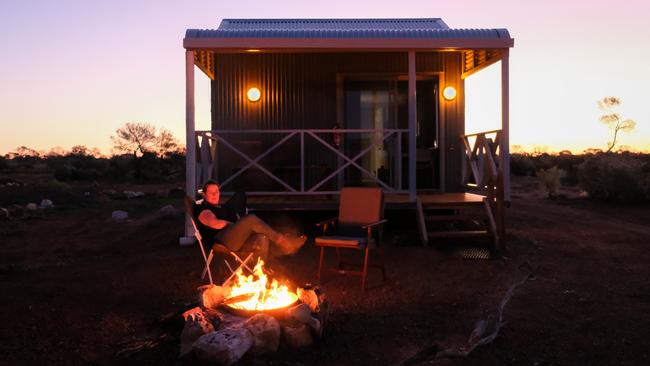
Mellenbye highlights include a visit to a granite outcrop to spot orchids, lizards and emus, but it’s a place called Breakaway Country, 13km from camp, that has piqued my interest. “The wildflowers down there have literally come out in the last week,” Shelley says, and my eyes light up.
We hurry to our car to follow Shelley’s farm buggy. Past cattle, and paddocks dusted with everlastings, we gaze out from a small cliff towards a dry lake, and see the creek that feeds it during northern cyclones. Over centuries, mighty boulders and chunks of river bank have tumbled towards the creek, exposing red, white and pink sediments. It’s stunning.
Back at our cottage, our campfire crackles as the sky loses its final glow. With no light pollution, the stars are impossibly bright. A meteor hurtles towards Earth, a stream of light flying out behind it like a comet’s tail. The mighty chunk of space rock glows an unearthly blue as it finally burns up.
Before we leave wildflower country, there’s one more item to tick off the list. On the grey nomad grapevine, I’ve heard that down a remote road from historic Pindar is the largest expanse of wreath flowers in the world (granted, they only grow in WA).
Barrelling down the dusty road, we brake at an odd intersection marked with a sign that reads “Wreath Flower Parking”. Proceeding on foot, we are staggered at the sight. Not five or 10 wreaths, but hundreds of the circular plants in various stages of flowering.
It’s the mother lode, floral perfection clinging to both sides of the track for as far as we can see. Camera in hand, I drop to my knees. I’m sold, committed, besotted with wildflowers and I vow to come back every spring.
Carolyn Beasley was a guest of Tourism WA.
In the know
Western Australia’s wildflower season runs from July to November, depending on location. The Wildflower Way covers the region northeast of Perth known as the Wheatbelt; the best time to visit is August to October.
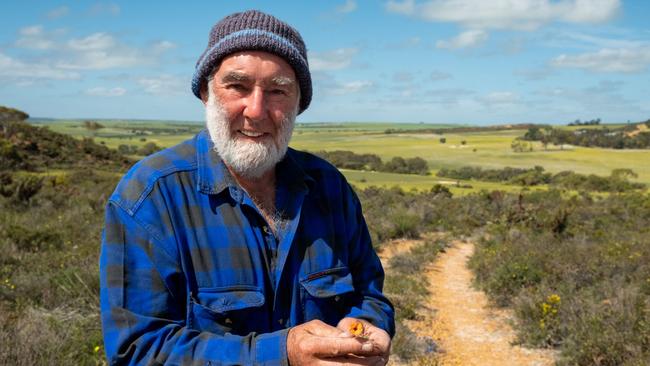
Perenjori Caravan Park accommodation ranges from unpowered tent sites at $15 a night to the two-bedroom, self-contained Park Home at $165 a night.
Mellenbye Station Stay has campsites for $10 a person a night, shearers’ quarters from $20 a person and ensuite homestead rooms from $80 for two. New cabins and cottages are from $130 for two. All have access to cooking facilities and a personal fire pit.
More to the story
A–top the green hills near Eneabba sits Hi Vallee, a working sheep farm. Some 400ha here have never been cleared, and this remnant vegetation supports more than 520 types of plants. Don and Joy Williams have been running wildflower tours for 30 years and their passion is evident in every sentence.

This area is one of the richest places for plant diversity in the world. Many factors have contributed to this, including the ancient unchanging landscape, the diverse soil types and low nutrient levels, and being in the overlap zone between northern and southern species.
At the farmhouse, we jump in Don’s dual-cab ute and bump along over the creek, past shady campsites. The wonder starts as we enter the Kwongan, the low heath covering the hillside. We’re astonished by the flowers at our feet. A yellow feather flower has many tiny blooms on the one stem, some of which are red, the plant’s signal to the insects that these have already been pollinated.
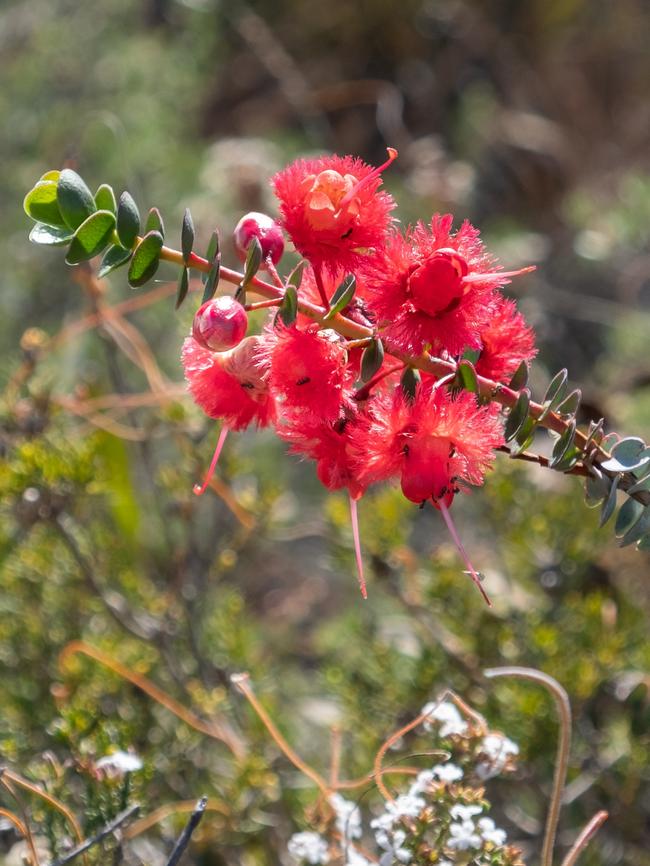
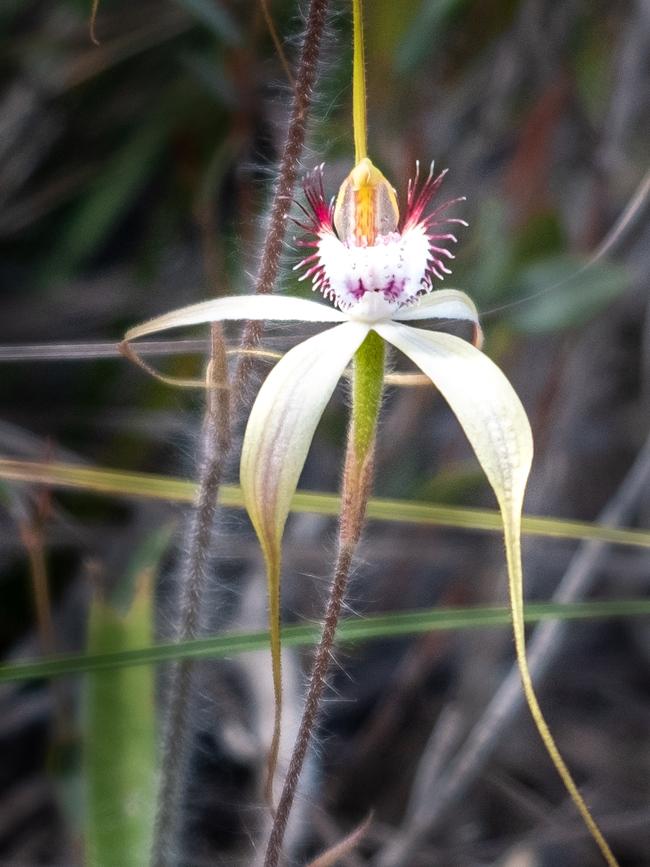
Next, Don shows us two astonishingly fine spider orchids. Centimetres away, he pinches out an orange sundew flower. He holds up the innocent-looking flower, showing us the hairy leaves it uses to kill insects. Right alongside, a scarlet feather flower blooms in hottest pink.
The plants Don shows us are astounding. We view ground-dwelling species, flowering shrubs, and strappy eucalypts that only occur within a 60km radius.
Over lunch we chat like old friends, and they send us on our way with Australian-grown tea and chocolate slice.

To join the conversation, please log in. Don't have an account? Register
Join the conversation, you are commenting as Logout